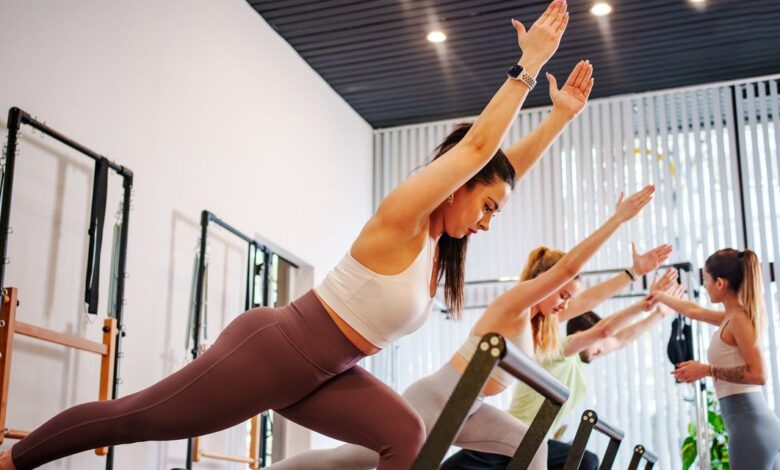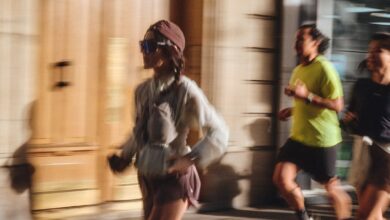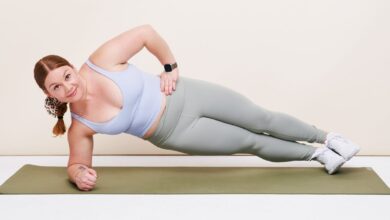7 Little Things Pilates Instructors Really Wish You'd Stop Doing in Class

Pilates isn’t like a lot of other workouts. Rather than pushing to go faster or harder or do more, the challenge often comes from moving very specifically with precise control. To an outsider’s eye, sometimes it honestly doesn’t look like you’re doing much at all. “It might feel very different than what you’re used to,” certified Pilates instructor Jennifer Phelan, founder of JPPilates in Boston, tells SELF. That means bringing old fitness habits with you isn’t always helpful; you might need to take a slightly different approach from usual.
This can make Pilates sound intimidating, but it doesn’t have to be. To be sure we know exactly how we should be tackling this workout, we asked a handful of Pilates instructors about the most common mistakes they see students make—and what we can do instead to get everything we can out of stepping into the studio.
1. You rush through the exercises.
The pace of Pilates can often be uncomfortably slow. But that’s on purpose: Rather than letting momentum do a bunch of the work, Pilates builds strength by moving in a steady, controlled way. This gives you time to focus on proper form—keeping your spine neutral and not arching, and your hips even—which is essential to getting the full benefits (and avoiding injury).
So when students speed up exercises in a mistaken attempt to make them more challenging or simply get them over with faster, they miss out. “Faster doesn’t mean that it’s harder or better,” Phelan says. “In fact, it’s really challenging to move at a slow and mindful speed.”
Certified Pilates instructor Chelsea Stewart, founder of HAVN Hot Pilates in Denver, tells SELF that when you rush through the motions, you’re less likely to engage the right muscles. “When you’re going so fast, the integrity of the move has now gone away.” Remember, Pilates isn’t meant to be a cardio workout—it’s designed to strengthen your muscles and improve your stability.
What to do instead: Don’t worry about getting your heart rate up during Pilates. Take things slow enough that you can zero in on activating the right muscles, Stewart says. “Really listen to the tempo that the instructor sets and try to follow their cues,” Phelan adds.
Hint: If you focus on moving with proper form at all times, you won’t have any choice but to do the exercises at the right pace. One cue Stewart likes to give clients is to think of their pelvis as a bucket filled with water. “If you’re pushing your butt back [or] too far forward, then the water spills out,” she says. Thinking about keeping the bucket level will help put your lower spine and hips where they’re supposed to be.
2. You hold your breath.
In Pilates, how you breathe isn’t just a supplemental afterthought; it’s a choreographed part of every exercise, designed to assist your form. “The breath is just as important as the actual movement,” Phelan says. Yet it’s all too common for students to hold their breath rather than follow the instructor’s inhale-exhale cues.
This can make the movements feel so much harder than they need to be. “When you’re coming up to a full teaser from a lying down position, if you don’t breathe, your performance will not be good,” certified Pilates instructor Nofar Hagag, founder of Nofar Method in New York City and Miami, tells SELF. Stewart explains that when you exhale correctly on a contraction, you’re able to get more muscle engagement in your core. It’s easy to see how this works: “Even just sitting down, if you contract your core and exhale, you’ll see how much more activation you can get instead of just trying to contract,” she says.
What to do instead: The general rule in Pilates is to inhale during the part of the movement when you’re lengthening, then exhale during the contraction, Stewart says. So for example, during the Double Leg Stretch, you’ll breathe in when you extend your arms and legs away from you, then breathe out as you curl them back toward your chest. She acknowledges that a good instructor can be a huge help by cuing the breath effectively (without becoming such a broken record that the room tunes them out). But if you’re relying on yourself, just try to get into the habit of exhaling forcefully during any contractions—once you’ve pushed out that air, your lungs will then automatically suck in more.
3. You chat with your besties mid-class.
Pilates has become übertrendy these days, which means it’s sometimes turned into a social event, with chatty conversations infiltrating the studio. “You’ll get a group coming to class, they go get coffee after, and they’ll start talking,” Stewart says. Carissa Fernandez, a certified master Pilates instructor for Club Pilates in Colorado, tells SELF she sees this happen at least once or twice a week.
While a quick “Woo, girl!” after a tough move can spread good vibes, having a full-on convo can disrupt both the teacher and other students. And if you have enough energy to chat, you’re probably not putting as much effort into class as you could be. (Not to mention, it’s hard to pull off those all-important inhales and exhales when you’re busy yakking.) “You don’t want to spend 45 minutes to an hour half-assing your workout and then be like, ‘Oh my gosh, I have to go work out again,’” Stewart points out.
What to do instead: Dial in during your workout—you paid good money for it, after all—then catch up with your friends. Find it’s simply too tempting to gab between leg circles? Fernandez suggests setting yourself up on the opposite sides of the room. Or, if you’re just really in need of a good vent sesh, ditch the studio and get your sweat in by going for a walk or run together instead.
4. You bring distractions with you.
We get it: We’re all busy, and the drive to multitask can get the better of us when our devices let us easily connect to work, our families, and all our other obligations. Hagag says she’s seen people leave a voice memo on their watch in the middle of class, and even had clients leave Zoom running on their phones so they can “be” at a meeting remotely (off-camera, of course).
But these distractions take away from what you could otherwise be getting out of the workout, particularly since so much of Pilates is about that mind-body connection and deep concentration on form. “If you’re not present in the workout, you really get only 50% of the benefit, in my opinion,” Hagag says.
What to do instead: Even if you’re not actively scrolling Instagram during The Hundred, it’s all too easy for a notification to steal your attention. So it’s best to leave your phone out of the studio if you can, and set your watch to Do Not Disturb.
As a business owner herself, Stewart understands that this can be tough. She suggests framing the challenge of disconnecting as a mindfulness practice. “It’s the ultimate trust-fall that everything is going to be okay for 45 minutes to an hour,” she says.
If that’s not possible—maybe you’ve got a sick kid or you’re on call—give the instructor a heads up. Stewart says that for students who want it, teachers at her studio will sometimes keep an eye on the student’s phone at the front of the studio in case anything comes up, giving students the chance to work out distraction-free.
5. You try to keep up with your neighbors.
With legs reaching into the air at all angles, it’s easy to start to compare your positions to the person next to you during group classes. But trying to match your neighbor misses the point. “Pilates isn’t about how you look, but how you feel when you’re practicing it,” Phelan says. Just because someone can straighten their leg all the way while you can’t, that doesn’t mean they’re doing it better than you are, she says. “You just might not be as flexible as them, but you’re still working your core in the same way.”
What to do instead: Instead of looking around the room, reflect on how you move and how you breathe, Hagag says. “Everyone has a different body, different needs,” she says. “Maybe what spring works for you doesn’t work for them.”
Phelan recommends thinking back to what drew you to class in the first place: It was likely to feel stronger and more powerful in your own body, not to copy the person next to you. If you find yourself struggling to stop the comparisons, try closing your eyes during certain exercises to refocus inward, she suggests.
6. Your clothes hold you back.
Despite what fitfluencers on TikTok might have you believe, there’s no one right “Pilates aesthetic” to wear to the studio. Yet you do want to make sure your outfit is serving you. “I don’t love when clients show up wearing really baggy, loose-fitting clothes,” Phelan admits. As comfy as your fave sweats and oversized T-shirt may be, they can keep your teacher from being able to check on your form. “If I can’t see your spine moving or what’s happening in your pelvis, it can be really tricky for me to give feedback,” Phelan says.
On the other hand, Fernandez says she’s had students take class in jeans when they’ve forgotten to bring workout clothes. “It’s a little hard to get your dexterity in your knees when you’re wearing hard pants,” she says.
Also: Pay attention to the studio’s rules around socks. Some, like Club Pilates, for instance, require students to wear grip socks for better traction (and hygiene). Other instructors encourage bare feet so you have a more tactile connection to the mat or equipment. Just be sure to take off your everyday cotton socks that can leave you slipping and sliding around.
What to do instead: Your clothes don’t need to be skin-tight, Phelan says. Just make sure they’re form-fitting—and stretchy—enough around the low back and pelvis so that your instructor can see your alignment as you move through the exercises. If you forgot your usual gear at home, Fernandez says that’s why studios often sell apparel in the lobby (even if it is on the expensive side).
7. You don’t speak up.
The instructor is there to help you get the most out of the workout, so share the info they need to help make that happen. Maybe it’s your first time or you have an injury or pregnancy that might limit certain movements—so tell them. “It’s easy to modify everything,” Fernandez says. “We just need to be aware of what we have to modify.”
If you simply try to make your own way through the exercises yourself, you could further injure something or just not get the full benefit, Fernandez says. “You’re going to get a way better experience if you let your instructor know what’s happening,” Phelan adds.
What to do instead: At the start of class, most teachers will ask if there are any first-timers or injuries they should know about, so speak up. “You don’t need to do a deep dive—a couple of sentences letting your teacher know what’s going on,” Phelan says. Of course, you might not want to blurt out something personal in front of an entire room. You can always pull the teacher aside before class begins or give the front desk a heads up so they can pass it on, Fernandez suggests. “I get emails from students who will say, Hey, I got injured last weekend. Is there anything I should know before class?” Phelan says.
Of course, sometimes we don’t realize something’s not right until mid-way through a workout. In this case, Phelan suggests flagging down or making eye contact with the teacher so they can come over to help you.
Don’t let these tendencies stop you from practicing.
If some of these mistakes hit a little close to home, don’t beat yourself up. Even the most dedicated Pilates practitioners can be guilty of them from time to time. “I can find myself getting misaligned and out of form, so I too constantly have to check in, slow down, and remind myself that form and alignment is key!” Stewart admits.
The good news? The more consistently you practice, the more you’ll strengthen that mind-body connection that Pilates emphasizes, and make the right habits come naturally. In the meantime, don’t let the intimidation factor of Pilates keep you from trying—even if you have to “fake it” a bit until you figure out the right approach, Stewart says: “Do not worry. You are going to be great.”
Related:
- 17 Pilates Exercises That Really Work Your Core
- Do You Really Get a ‘Better’ Workout With Lagree Than With Pilates?
- Does Pilates ‘Count’ as Strength Training?
Get more of SELF’s great fitness coverage delivered right to your inbox—for free.



